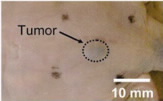FOR IMMEDIATE RELEASE
ACS News Service Weekly PressPac: August 11, 2010
Advance toward earlier detection of melanoma
Scientists are reporting development of a substance to enhance the visibility of skin cancer cells during scans with an advanced medical imaging system that combines ultrasound and light. The hybrid scanner could enable doctors to detect melanoma, the most serious form of skin cancer, in its earliest and most curable stages, the report in the monthly journal ACS Nano: “In Vivo Molecular Photoacoustic Tomography of Melanomas Targeted by Bioconjugated Gold Nanocages” indicates.
Lihong Wang, Younan Xia, and colleagues point out that early diagnosis is key to improving survival in patients with melanoma. The five-year survival rate for melanoma is about 98 percent if detected early but can be as low as 15 percent when detected at an advanced stage. Existing imaging techniques for early detection of melanoma produce low-quality images, can “see” only a fraction of an inch below the skin, and use potentially harmful radioactive materials. A promising new technique called photoacoustic tomography (PAT) can overcome these problems. The system shoots light into tumors, which slightly heats up the cancer cells and produces high frequency sound waves that provide images of the tumor. But the PAT system lacks an optimal contrast agent that can easily enter skin cancer cells and make them visible.
The scientists developed such an agent by attaching a peptide (one of the building blocks of proteins) that targets skin cancer cells to gold “nanocages.” These hollow gold nanoparticles have a box-like shape and are barely 1/50,000th the width of a human hair. When injected into mice with skin cancer, the nanocages improved the image quality of the cancer cells by three-fold compared to nanoparticles lacking the peptide. The gold nanocages also show promise as a way to kill skin cancer cells using heat or anti-cancer drugs, they add.
![]()
Contact
Science Inquiries: Michael Woods, Editor, 202-872-6293
General Inquiries: Michael Bernstein, 202-872-6042

treatment with a new contrast agent
that can improve the visualization of
skin cancer cells (bottom) using an
advanced medical imaging device.
Credit: American Chemical Society
(High-resolution version of tumor)
(High-resolution version of
contrast agent)

